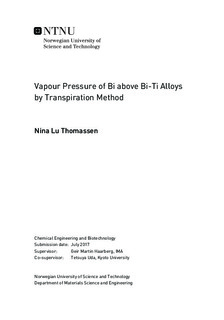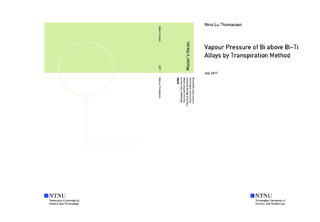| dc.description.abstract | Titanium is an attractive metal with wide-ranging applications due to its properties. Titanium is one of the most corrosion resistant metals with the highest strength-to-weight ratio. The only industrial production route for titanium today is by the Kroll process, which involves a magnesiothermic reduction of TiCl4. However, this process is slow and inefficient, and a new production route for titanium is therefore desirable. Recently, a more efficient alternative production route was proposed by Kado et al. [1], involving magnesiothermic reduction of TiCl2 into a liquid Bi cathode. However, to determine the feasibility of this new method, a better understanding of the underlying operating conditions is still required. In this work, the thermodynamic properties of the Bi Ti system are therefore experimentally investigated. Specifically, various vapour pressure measurements were carried out to determine the vapour pressure of Bi above various samples by the transpiration method. The samples were pure Bi, Bi 30mol%Ti alloy, Bi 40mol%Ti alloy, Bi 50mol%Sn alloy, and Bi 70mol%Sn alloy at 900◦C. Additionally, a few experiments were conducted with pure Bi at 800◦C. Using previous literature, the expected value for the vapour pressure of Bi over Bi Ti alloys were calculated and compared to the empirical values, but no agreement was observed as the empirical values were too high. Therefore, measurements with Bi Sn alloys were performed in order to verify that the experimental equipment was operating correctly. The literature value for the vapour pressure of Bi above Bi Sn alloys was also calculated and compared with the measured values, and determined to be in great agreement, indicating that the experimental equipment was operating as predicted. | |

